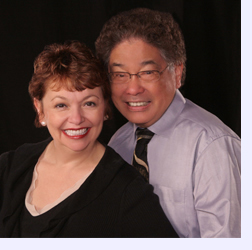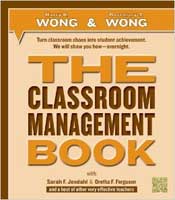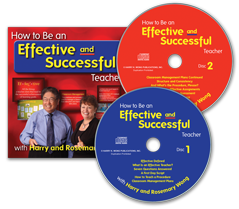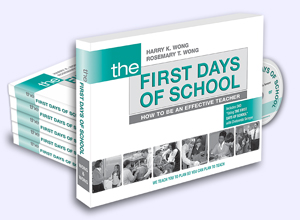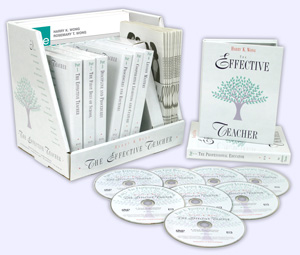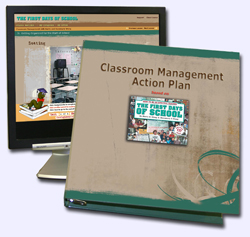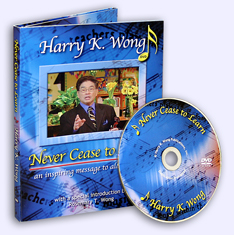|
 |
|
| |||||||||||||||
| by Harry & Rosemary Wong Special to the Gazette February 2011 |
|||||||||||||||
Even Shakespeare Had Structure
Give Them the Structure to Create As the Theater Arts Director at Rainier Junior/Senior High School and the Student Services Director for her district, Laurie Kash has directed over fifty theatrical productions and showcases. She also teaches English, Writing, World Literature, Basic Theater, Advanced Theater, and Alternative Education Arts classes. She typically directs two mainstage productions and two showcases each year. How she can juggle so many roles and shows is quite simple—she’s organized and her cast members are organized, too. Through the use of procedure and routines, she brings theater off the page and into the lives of her students each and every day. She uses procedures, disguised as games and theater exercises, to keep her classes efficient, full of energy, and most importantly, entertained! Effective fine arts teachers know, as most all other teachers know, creativity is enhanced when there is a sense of order to bring out the potential creativity of students. Art teacher, Jeanne Bayless of Las Vegas is so effective that a giant mural produced by her students is on permanent display at the McCarran International Airport in Las Vegas, Nevada. She says:
Click here to read the teachers.net article that featured Jeanne and her procedures. Limitless Possibilities Through Structure Laurie understands the importance structure can have on the creative process. Many people claim the key to true creativity is to have no limits. But Laurie understands that in the classroom, structure can open students to new and limitless possibilities. Laurie says, Having predictable and reliable procedures for managing an arts class does not stifle General Management Procedures Just like actors need to rehearse a play before they can perform it well, students need to rehearse procedures to perform them well. Even the most experienced pianist playing a Rachmaninoff sonata doesn’t perform it perfectly the first time. Likewise, students can’t be expected to perform procedures perfectly without practice, practice, practice! On the first day of school, Laurie invites her students to join her on the stage in a circle. She explains this is how they will begin class every day. The procedure is explained, demonstrated, and rehearsed. So on every day of the year thereafter, starting class is simple. Laurie says, “Circle up! Five, four, three, two, one!” and every student is waiting and ready to begin—in the circle formation. In theater classes, as in all classes, it is especially important to keep the energy going from the first bell to the last. Laurie’s motto in class is, “Never let ‘em see you sit!” To keep the energy up throughout the class, there are no chairs in Laurie’s classroom. Instead, she demonstrates and models the actions she would like from her students by participating on her feet and roaming between students during group work. Laurie uses five signals to help keep her class running smoothly:
Like the Circle Up procedure, these five commands are introduced on the first day of school. They are demonstrated, rehearsed, and maintained throughout the school year. By taking the time to teach these six simple procedures on the first day, Laurie saves herself hours of time that she would have spent corralling and quieting her class between each activity every single day of the school year. No One’s Late for Class Athletes and musicians know the importance of warming up before a performance. Similarly, it is important to begin every acting class with a warm up. These silly and fun games get students energized and focused, while also introducing new concepts for study that day. Before the games begin, Laurie first explains the concept the students will practice and then introduces the warm-up game or activity. Students know what the purpose is for the game or activity. Warm ups are usually full group improvisational or theater games, so Laurie can establish the group as a whole at the start of each class. She never has problems with students being late to class, because they all think her class is fun and exciting. Grouping Techniques Laurie’s method for creating groups breaks up predictable grouping patterns and creates teams with new players each time. One of her ways of forming groups is called Numbered Body Parts. And just as the name implies, Laurie calls out a number and then a body part. If she calls out, “Three elbows!” students gather in groups of three and touch their own elbow. If a group is missing people, they hold up the number of fingers of people they are missing and call out that number. Students not yet in a group, make their way to a group in need of someone to complete the group.Once everyone has found a group, Laurie will call out another number and body part. This time, students must form a new group that does not include any of the students that were just in their previous group. This continues until they reach a final grouping. Students remain in that final group and find a space in the room to do their assigned task. Another procedure Laurie uses for pairing students is Tall to Small. She asks students to line up in order of largest to smallest of something. This can be anything from height to hair length to the number of buttons they have on. She then pairs the student on the right end of the line with the student on the left end, working in towards the center of the line until everyone is paired. Creating Boundaries While exploration and expression are important in an arts class, creating a safe space for students to work in is just as important. Laurie uses a Yellow Flag Procedure and Red Flag Rule to redirect students who may have crossed a line. If a student begins to tell a story or make a remark that is inappropriate for a school setting, Laurie will call, “Yellow flag!” This means that the student must choose a new direction for his story or reverse his remark. If the student continues his story or remark in an inappropriate manner, Laurie calls, “Red flag!” and the student must stop speaking and sit out for the remainder of the exercise. Yellow Flag is a procedure because it dictates how things are to be done, without mention of penalties or rewards. Red Flag is considered a rule because it dictates a consequence for how a student behaves. To review the difference between rules and procedures, please read pages 168 and 169, “The Difference Between Discipline and Procedures,” in The First Days of School. Rehearsal Time At first Laurie was frustrated with students wasting time during their individual or small group rehearsal time. The students were always asking for “just one more day” to prepare their work. She now structures her rehearsals by creating a high-support, high-control environment. Before beginning rehearsal, she tells her students the objectives of the lesson. She gives the students a time limit and specific goal to reach within that time. As the students work to solve the problem together, Laurie announces amount of time left. Students can also signify that they have completed the assignment by sitting quietly. The structure for rehearsals limits the amount of time students spend chatting. It forces students to be spontaneous in their answers. It doesn’t allow time for students to edit themselves or get self-conscious. And of course, it keeps rehearsal moving forward at a quick and energetic pace!Show Time After rehearsing a scene, students are asked to give a final performance to the class to demonstrate their progress. These informal progress performances are done throughout the school year. Laurie calls these presentations "Informances"—informal, informed performances! Before "Informances" begin, students are reminded of the criteria for grading and the desired outcome. Each student is given a copy of the scoring guide that is correlated to the state performing arts standards. With these qualitative statements, students understand their critiques are focused on the art and not on the artist. Students are given three minutes to gather whatever they need for their performance. Once the show starts, students are not allowed to get up during a performance. Laurie maintains a very strict “The Show Must Go On” protocol. This means no matter what, students must perform on the day of performances. There are no excuses—feeling sick or an absent scene partner—Laurie expects her students to give their best effort. If students feel that it was not their best work, or if a scene partner was missing, they can choose to perform again during the next class period to earn a better score. Students perform on a volunteer basis. However, if no groups volunteer, Laurie will ask whose birthday is closest, and that student will choose who will go first. Each group that goes then gets to decide who goes next. There is no time wasted on arguing who has to perform first and what group follows. Procedures are in place and students know what they are and can be responsible to them. Evaluation and Critique At the end of the performance, Laurie leads the class in a group evaluation. Having procedures for critiquing allows students to feel safe and creates trust. With a group evaluation, students learn suitable terminology to discuss theater. They also learn the appropriate way to give criticism and praise to their classmates. Laurie’s students give their evaluation with the Roses and Thorns procedure. After the group receives their applause, they sit on the edge of the stage for their critiques. Laurie first reminds the class of the goals for the assignment. The performers then choose whether they would first like to hear Roses, positive feedback, or Thorns, constructive criticism. Laurie calls on students in the audience to share their thoughts. She teaches the performers to respond only with “Thank you.” By responding this way, students must consider the feedback they are receiving without becoming defensive. This allows the evaluation to run smoothly and in a safe environment. Once these procedures are in place, Laurie will ask a student volunteer to lead the discussion while she concentrates on written comments. Ending Class Laurie ends every class with a review of the objectives for the day. She uses a modified version of the business management tool “Fist to Five” to assess student understanding. Students are asked to show on a scale of zero to five how well they thought they achieved the day’s objective—a fist (zero) being total confusion and five fingers being complete understanding. Laurie uses a group exercise to bring closure to the class. One exercise she suggests is the Hand Slap Game. Students lay on their stomachs in a circle so that their arms overlap with the right arm on top of the left arm of the student next to them. The exercise starts with a designated student slapping the floor with one hand. This slap is passed around the circle to the right as fast as it can go. Once this slap is going, Laurie adds another hand slap that creates more pulses of multiple hand slapping going around the circle. The students are reunited and reconnect with great energy to end the period. Even Auditions Have Procedures Managing an audition is the same as managing a classroom. A few simple procedures, implemented and rehearsed from the start, allow the time to be focused on casting and gives students the tools they need to be successful. Just like in the classroom, procedures only work if they are properly introduced and rehearsed from the very beginning. Laurie holds practice auditions for her students the day before the actual audition date. During the practice auditions, she reviews her procedures for any new students and to remind students who have auditioned before. Laurie has a procedure for everything to keep things running smoothly. These are some of the procedures she has in place: Laurie notifies students about fifteen minutes before auditions are over to call their rides. This helps to get students off campus quickly and efficiently as soon as the auditions are over. During the practice audition, she talks to students about how they show respect for their fellow performers and for the auditors. She emphasizes behavior at an audition is important both onstage and off and reviews how students are to conduct themselves when not onstage. Laurie has even developed a procedure for clapping! So every student gets the same amount of praise for their auditions, she uses the One, Two, Three, CLAP! procedure. After each student auditions, Laurie calls out, “One, two, three . . .” and everyone claps once. This is introduced and rehearsed at the practice audition and then reviewed again at the start of the auditions. Procedures are even more important for audition time. Fairness and objectivity are fundamental. Procedures for an audition help assure that every student gets a fair chance. Laurie has a rubric for auditions. Audition forms detail exactly what she will be looking for during auditions so that students know what and how to prepare. Audition forms also make it easier for her to take notes during a student’s audition. With a list of qualities she is looking for, she can circle or highlight what she sees without having to write it out. Procedures Are Not Limits Orson Welles, the respected American filmmaker, actor, theater director, screenwriter, and producer said, The enemy of art is the absence of limitations. Procedures can enhance creativity, instill trust, and aid student achievement. Giving students parameters in which to create, will push students to explore and develop outlets of expression that might not otherwise surface. Guiding students in a safe and predictable environment allows for freedom of expression, taking risks, and dreaming without fear of ridicule. Procedures allow students to do—to grow—to consider—to become. Structure Is the Frame for Creativity
Procedures set the rhythm for your classroom. Create a predictable classroom environment so students can devote their energy to learning, growing, and achieving. Become the “Bard of the Classroom” with a scheme of procedures for your success and your students’ success.
|
|||||||||||||||
|

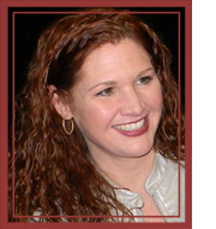
 William Shakespeare is viewed as the greatest writer—ever—of the English language. Some of his highest regarded writings are his 154 sonnets. These sonnets are written in an ABAB rhyme scheme called iambic pentameter. The rhyme scheme sets a rhythm for the flow of the words. These sonnets are strict in form, but imaginative in content. Within these boundaries, Shakespeare created literary works that are still studied and emulated in classrooms and performed in theatres around the world.
William Shakespeare is viewed as the greatest writer—ever—of the English language. Some of his highest regarded writings are his 154 sonnets. These sonnets are written in an ABAB rhyme scheme called iambic pentameter. The rhyme scheme sets a rhythm for the flow of the words. These sonnets are strict in form, but imaginative in content. Within these boundaries, Shakespeare created literary works that are still studied and emulated in classrooms and performed in theatres around the world.